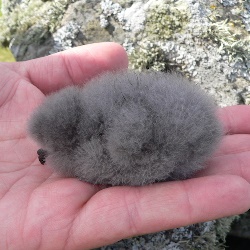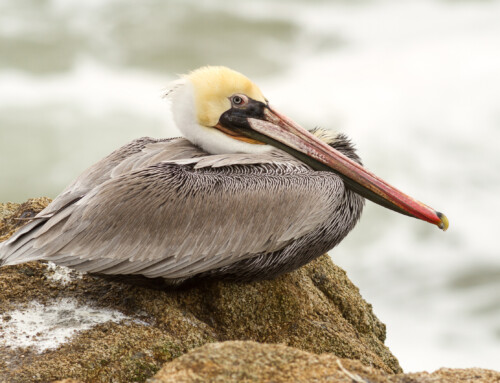LINKED PAPER
Assessing the effects of repeated handling on the physiology and condition of semi-precocial nestlings. 2016. Watson, H., Bolton, M., Heidinger, B.J., Boner, W. & Monaghan, P. IBIS. DOI: 10.1111/ibi.12402. VIEW
As an ecologist, primarily studying breeding birds, I find myself handling large numbers of wild birds, both adults and nestlings. Indeed, the handling of birds and other animals is commonplace, carried out by field ecologists, bird ringers, and conservation workers for the purposes of research and monitoring. It is well understood that handling birds can have both short- (e.g. increased breathing rate and body temperature) and long-term (e.g. increased energy expenditure) effects on birds. However, as investigators, we rarely consider how repeated capture and handling could bias the very data that we are trying to collect, whether this be survival, levels of stress hormones, body mass or indeed any other metric.
During my PhD, I spent three consecutive seasons studying European Storm Petrels Hydrobates pelagicus on the island of Mousa, an RSPB reserve located in Shetland (UK). One of the primary aims of my research was to understand how human disturbance – associated with tourism – could impact Storm Petrels. While Storm Petrels and related species (e.g. shearwaters, Fulmars, albatrosses) typically breed in isolated locations, Mousa is easily accessible and receives one or more boat-loads of tourists almost daily throughout the spring and summer. We found that human disturbance did in fact lead to lower breeding success of Storm Petrels, but that, under the current visitor management plan, the effects at the population level were very small (Watson et al. 2014).

Aside from effects on breeding success, myself and my co-authors from the University of Glasgow and RSPB Centre for Conservation Science were especially interested if exposure to a stressor, such as human disturbance, could affect growth and stress physiology (i.e. the mechanisms that enable the body to cope with stress) in nestling Storm Petrels. Of course, in order to quantify growth patterns and to understand how physiology changes over the course of development of a nestling, we needed to handle young birds repeatedly during the time spent in the nest. Thus, we recognised that it was important for us to be able to demonstrate that we – as scientific investigators – were not causing sufficient stress to the birds ourselves, which could subsequently obscure or exaggerate any observed effects of tourism on growth and physiology.
Stress hormones – known as glucocorticoids – are one of the main mechanisms by which all vertebrates, including ourselves, deal with stress (Wingfield, 2003). Glucocorticoids typically rise following a stressful incident and help the body to cope and respond appropriately to the stressor. For a bird, such a stressful event could be a predation attack or the onset of a storm, and the proper actions of stress hormones can facilitate survival in such instances. Once the stressor has passed, glucocorticoid levels usually fall back to baseline again. However, if an individual is exposed to a repeated or persistent stressor, glucocorticoid levels may remain permanently elevated, which can have damaging consequences. For example, long-term elevation of stress hormones can impede growth and reduce immune function in young birds. Furthermore, high glucocorticoid levels have been shown to cause accelerated shortening of telomeres (the protective caps located at the ends of our chromosomes), which has, in turn, been associated with the onset of ageing and premature death (Monaghan, 2014).
By exposing nestling Storm Petrels to different levels of handling over the course of the rearing period, we were able to demonstrate that handling had no effect on Storm Petrel chicks. We observed no changes in either glucocorticoid levels, the length of telomeres, or body condition, as a result of handling. Thus it seems that, within the scope of a typical field study, Storm Petrel nestlings are able to avoid the negative effects associated with long-term elevation of stress hormone levels. This could represent an evolutionary adaptation, since eliciting a response to a stressor may be of little benefit to a chick that is stranded in its nesting cavity and no means of defending itself.
In contrast to our results, a study undertaken by colleagues at the University of Glasgow showed that handling of nestling European Shags Phalacrocorax aristotelis led to both elevated levels of stress hormones and increased erosion of telomeres (Herborn et al. 2015). While Shags, like Storm Petrels, are colonial-nesting seabirds, they rear up to five chicks in nests that are situated out in the open, as opposed to Storm Petrels which rear a single chick tucked out of sight in a cavity. Furthermore, adult Shags are present during the day, when investigators visit nests, whereas Storm Petrel adults are far out to sea foraging by day, only returning to the nest at night, under the cover of darkness. Therefore, the presence of an investigator within a Shag colony will likely cause widespread disturbance among both adults and young and probably cause some adults to leave nests and young temporarily. In contrast, within a Storm Petrel colony, disturbance is isolated to the visited nest, where only the single chick is present, and should not generate disturbance elsewhere within the colony. We thus propose that the lack of response by Storm Petrel nestlings may in part be a consequence of their breeding ecology, which has not been previously considered by other authors.
References
Herborn, K.A., Heidinger, B.J., Boner, W., Noguera, J.C., Adam, A., Daunt, F. & Monaghan, P. 2014. Stress exposure in early post-natal life reduces telomere length: an experimental demonstration in a long-lived seabird. Proceedings of The Royal Society B 281: 20133151. VIEW
Monaghan, P. 2014. Organismal stress, telomeres and life histories. Journal of Experimental Biology 217: 57-66. VIEW
Watson, H., Bolton, M. & Monaghan, P. 2014. Out of sight but not out of harm’s way: Human disturbance reduces reproductive success of a cavity-nesting seabird. Biological Conservation 174: 127-133. VIEW
Wingfield, J.C. 2003. Control of behavioural strategies for capricious environments. Functional Ecology 66: 807-816. VIEW
Image credit
Featured image: European Storm Petrel Hydrobates pelagicus nestling
© Hannah Watson.




